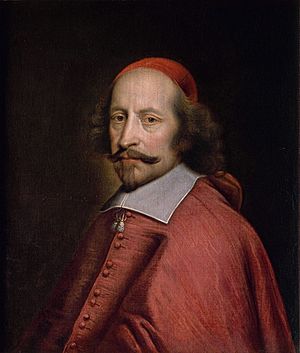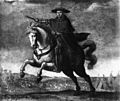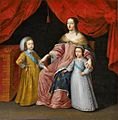Cardinal Mazarin facts for kids
Quick facts for kids
His Eminence
Cardinal Mazarin
|
|||||||||||||||||||||||||||
|---|---|---|---|---|---|---|---|---|---|---|---|---|---|---|---|---|---|---|---|---|---|---|---|---|---|---|---|

Portrait of Jules Mazarin by Pierre Mignard (1658)
|
|||||||||||||||||||||||||||
| First Minister of State | |||||||||||||||||||||||||||
| In office 4 December 1642 – 9 March 1661 |
|||||||||||||||||||||||||||
| Monarch | Louis XIII Queen Anne (regent) Louis XIV |
||||||||||||||||||||||||||
| Preceded by | The Duke of Richelieu | ||||||||||||||||||||||||||
| Succeeded by | Jean-Baptiste Colbert | ||||||||||||||||||||||||||
| Personal details | |||||||||||||||||||||||||||
| Born |
Giulio Raimondo Mazzarino
14 July 1602 Pescina, Abruzzo Ultra, Kingdom of Naples |
||||||||||||||||||||||||||
| Died | 9 March 1661 (aged 58) Vincennes, Île-de-France, France |
||||||||||||||||||||||||||
| Alma mater | Roman College | ||||||||||||||||||||||||||
| Profession | Clergyman, statesman | ||||||||||||||||||||||||||
|
|||||||||||||||||||||||||||
Cardinal Jules Mazarin was an important Italian cardinal, diplomat, and politician. He was born Giulio Raimondo Mazzarino on July 14, 1602. He became the chief minister of France, serving kings Louis XIII and Louis XIV from 1642 until he died in 1661. He helped shape France's future during a very important time.
| Top - 0-9 A B C D E F G H I J K L M N O P Q R S T U V W X Y Z |
Early Life and Education
Giulio Mazzarino was born in Pescina, Italy, on July 14, 1602. His family was from Rome. His father, Pietro Mazzarino, worked for a powerful family called the Colonnas. His mother, Ortensia Bufalini, also came from a noble family. Giulio was the oldest of six children.
When he was seven, Giulio went to the Jesuit College in Rome. This was the best school in the city. He was a brilliant student. At 16, he gave a public talk about Halley's comet. He was also good at acting.
When he was 20, his father sent him to study law in Spain. He went with Girolamo Colonna, a son of his father's employer.
Rise to Power in France
After finishing his studies, Mazarin became a diplomat for Pope Urban VIII. He then offered his skills to Cardinal Richelieu, who was France's chief minister. Mazarin moved to Paris in 1640.
When Cardinal Richelieu died in 1642, Mazarin took his place as chief minister. Soon after, King Louis XIII died in 1643. His son, Louis XIV, was too young to rule. So, Louis XIV's mother, Anne of Austria, became the regent. This meant she ruled until Louis XIV was old enough. Mazarin became the head of the government for Anne of Austria. He was also in charge of educating the young King Louis XIV.
Challenges and Victories
Mazarin's early years in power were successful. France won many battles in the Thirty Years' War. He used these wins to make France a major power in Europe. This led to the Peace of Westphalia treaties in 1646–1648. These treaties helped end the Thirty Years' War.
However, a big uprising happened in Paris in 1648. It was called the Fronde. Nobles and the Parliament of Paris led this rebellion against Anne of Austria and Mazarin. A second Fronde followed, led by Louis, Grand Condé, who was once an ally.
Mazarin had to take Anne of Austria and Louis XIV out of Paris for safety. He even moved his base to Germany for a while. A general loyal to Mazarin, Turenne, defeated Condé's forces. Mazarin then made a grand return to Paris in 1653.
Later Years and Diplomatic Successes
The last years of Mazarin's life were filled with major diplomatic wins. In 1657, he made a military alliance with England. In 1658, he created the League of the Rhine. This was a group of German states that allied with France.
In the same month, Marshal Turenne won a big victory. He defeated Condé's army at the Battle of the Dunes in Flanders.
Between February and June 1659, Mazarin had important talks with Spain. On November 7, 1659, Spain signed the Treaty of the Pyrenees. This treaty added new provinces like Artois to France.
In June 1660, Mazarin arranged an even more important event. This was the marriage of King Louis XIV to Maria Theresa of Spain. The wedding took place in Spain. The royal couple made a grand entry into Paris on August 26, 1660. This marriage and the agreements that came with it helped end the long wars between France and the Hapsburgs.
Death and Legacy
In his final months, Mazarin lived in the Louvre Palace. He died on March 9, 1661.
Mazarin left a large part of his wealth to create the Collège des Quatre-Nations. He founded this college for students from the new provinces France gained. This college is now the Institut de France. It is located across the Seine River from the Louvre. Mazarin's remains are buried there in a marble monument.
Mazarin was very important in shaping Europe. He helped create the Westphalian principles. These principles guide how countries deal with each other. Ideas like a country's control over its own land and equal rights among states are still part of international law today.
Mazarin also loved the arts. He brought Italian opera to Paris. He also collected many amazing artworks. Many of these can be seen in the Louvre today.
He was also a famous book collector. He had a huge library with over 25,000 books. It was the first true public library in France. He gave his library to the Collège des Quatre-Nations in his will.
Family
Mazarin did not have children of his own. However, he had seven nieces. Five were from his sister Girolama, and two from his sister Laura. All his nieces moved to Paris. Mazarin made sure they married into wealthy and important families. These nieces were known for their beauty and cleverness. They were called the Mazarinettes.
Images for kids
-
Anne of Austria with her children Louis XIV of France and Philippe, Duke of Orléans (unknown artist)
-
An anti-Mazarin cartoon from the Fronde (about 1650). The caption reads, "Despite Mazarin, the frondeurs assure the safety of the state."
-
Louis the Prince de Condé, leader of the second Fronde
-
Battle between the Fronde forces of the Prince de Conde and the army loyal to Anne of Austria and Mazarin
-
Nicolas Fouquet, the Superintendent of Finances
-
Portrait of Baldassare Castiglione, by Raphael, purchased by Mazarin from Richelieu
-
Marie Mancini, whom Louis XIV wished to marry
-
Hortense Mancini, Duchess Mazarin.
See also
 In Spanish: Cardenal Mazarino para niños
In Spanish: Cardenal Mazarino para niños





















